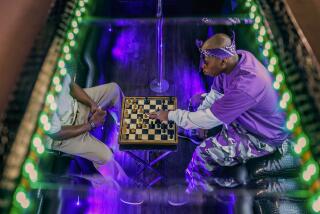Gata Kamsky wins U.S. Championship
Position No. 6109: White to play and win. From the game Marat Dzhumaev-Gurpreet Singh, Delhi 2010.
Solution to Position No. 6108: White wins elegantly with 1 Qh3 Rxf1+ 2 Rd1. To avoid checkmate, Black must yield both Rooks by 2…Rh4 3 Qxh4 Qh1 4 Qxh1 Rxh1 5 Rxh1.
Gata Kamsky of New York won the U.S. Championship on Tuesday in St. Louis. In an odd finish to the 24-player event, Kamsky drew to break a tie with Yury Shulman of Chicago.
The tournament began with seven conventional rounds. Then top scorers Kamsky, Shulman, Alexander Onischuk (Baltimore) and 2009 champion Hikaru Nakamura (St. Louis) qualified for a round robin to determine the top four places. Kamsky and Shulman scored 2-1, while Nakamura and Onischuk tied for third at 1-2. In the game that decided the title of champion and the $30,000 first prize, Kamsky chose to play Black with draw odds and 25 minutes against Shulman’s 60 minutes. Shulman gained a pawn but couldn’t win the game. He earned $25,000 for second place.
The remaining 20 players continued to fight for lower prizes. Alexander Shabalov of Pennsylvania officially finished fifth with 6-3.
Varuzhan Akobian of North Hollywood tied for seventh at 5-4, and Melikset Khachiyan of Glendale tied for 18th at 31/2-51/2.
Memorial Day Classic
John Daniel Bryant scored 41/2-1/2 to win the small but strong Memorial Day Classic last weekend in Los Angeles. Bryant defeated two International Masters and yielded a draw only to his stepfather, state champion IM Enrico Sevillano, who finished second at 4-1. Next at 31/2-11/2 were Alexandre Kretchetov, Julian Landaw, Gregg Small, IM Tim Taylor and this writer.
Other sections were won by David Oldham, 5-0 in Under-2000; Gee Yong Leong, 41/2-1/2 in Under-1800; Paul Cijo, Edgar M. Lopez and Hovanes Salvaryan, 31/2-11/2 in Under-1600; and Ruperto Dilig Jr., 5-0 in Under-1400.
The once-glorious tournament, which regularly attracted over 400 players in the 1980s, had a mere 86 entrants. John Hillery directed.
It’s doubtful if the shift away from Memorial Day weekend had much effect. Attendance has dropped at all tournaments, and a turnout of close to 100 players now seems normal for a weekend event.
There were 24 additional competitors in the two scholastic tournaments. Jimmy Revelino won the Scholastic Open, scoring 41/2-1/2. In the grades K-6 section, Arman Hairapetyan, Jeremy Mittman and Darrell Yap shared first place with scores of 4-1.
Jeff Phillips led the Action (30-minute games) event with 5-0, while Simone Liao and Fernando Sevilla tied for first at 21/2-1/2 in the Hexes.
Scholastic events
The AAA Chess Club plans a three-section scholastic tournament, with prizes for every entrant, Saturday at First Lutheran Church, 1300 E. Colorado Blvd. in Glendale. See aaachessclub.com for more information.
Hanley’s Chess Academy, 7390 Center Ave. in Huntington Beach, will conduct the first Dewain Barber Scholastic next Sunday. The tournament, which features rated and nonrated sections, honors one of the longest-serving scholastic organizers. For details, call Hanley at (714) 925-3195 or see hanleychessacademy.org.
Today’s games
GM Gata Kamsky-GM Larry Christiansen, U.S. Championship, St. Louis 2010: 1 e4 e5 2 Nf3 Nc6 3 Bb5 Bc5 The Classical Defense to the Ruy Lopez. 4 0-0 Instead of the customary 4 c3. Nd4 5 Ba4 Nxf3+ 6 Qxf3 Ne7 Not bad, although Capablanca once chose the more natural 6…Nf6 7 Nc3 0-0. 7 Qc3!? Bd4 8 Qg3 Ng6 9 c3 Bb6 10 d4!? Kamsky said he wanted to play aggressively against Christiansen, a noted attacker. He invites 10…exd4 11 Rd1 dxc3 12 Nxc3. 0-0 Not fearing 11 dxe5 Qe7 12 Bf4?!, as 12…d6! 13 exd6?? Qxe4 costs White a Bishop. 11 f4 exf4 Prudent. Black’s position is unpleasant after 11…exd4 12 f5 dxc3+ 13 Kh1 Bd4 14 Nxc3 Be5 15 Qd3 Ne7 16 Bf4. 12 Bxf4 Nxf4 13 Qxf4 d6 Chances are even. 14 Nd2 Be6 15 Kh1 c6 16 Nf3 h6 Sturdier is 16…f6, observing both g5 and e5. 17 Bc2 Qd7 Here or next move, Black should guard e5 by …Bb6-c7. 18 e5 dxe5?! 19 Nxe5 Qd6 20 Qg3 Suddenly White has threats of 21 Rf6 and 21 Qd3. f5 21 Rae1 Bc7 22 Qh3 f4? White will pounce on the b1-h7 diagonal. Black could hang on by 22…Rae8 23 Bxf5 Bxf5 24 Rxf5 Qd5. 23 Qd3 Bf5 24 Bb3+ Kh7 26 Qd2 g5 26 g4! Reclaiming the most important diagonal. Black cannot reply 26…fxg3 because of 27 Rxf5 Rxf5 28 Qd3 Raf8 29 Rf1, when 29…Qg6 loses amusingly to 30 Rxf5! Bxe5 31 Bf7!. Bc8 27 Qd3+ Kg7 28 Bc2 Rh8 29 Ng6 Bxg4 Rook moves permit 30 Nxf4. 30 Re7+ Kf6 31 Rxc7 Rhg8 If 31…Qxc7, either 32 Nxh8 or 32 Nxf4 gxf4 33 Qg6+ Ke7 34 Re1+ Kf8 35 Qf6+ clinches the win. 32 Ne5, Black Resigns.
GM Ray Robson-GM Alex Yermolinsky, U.S. Championship, St. Louis 2010: 1 e4 c5 2 Nf3 Nc6 3 d4 cxd4 4 Nxd4 Qb6 A neglected line of the Sicilian Defense, introduced by Louis Paulsen in 1881. 5 Nb3 Nf6 6 Nc3 e6 7 Qe2 For rapid castling. More popular are 7 Bd3 and 7 Be3 Qc7 8 a3. Bb4 8 Bd2 0-0 9 a3 Be7 10 0-0-0 d5!? Accepting a vulnerable d-pawn in return for easy development. 11 Be3 Qc7 12 exd5 Nxd5 13 Nxd5 exd5 Welcoming 14 Rxd5 Be6 15 Rd1 Rfd8 16 Kb1 Bf6, with adequate compensation. 14 g3 Bf5 Bolder than 14…Be6 or 14…Ne5. 15 Bg2 Rac8 16 Bf4?? One mistake dooms White. Safest is 16 Rd2 Rfd8 17 Nd4. The greedy 16 Rxd5 Be6 17 Rb5 seems playable too, as White can survive 17…Nb4 18 Nc5! and 17…a6 18 Rb6. Qb6 Thinking of 17…Qxb3. 17 Rxd5 Similarly hopeless is 17 Bxd5 Bxc2. Nor does 17 Rd2 help, as 17…Bf6 prepares the deadly …Nc6-a5. Then 18 Bxd5 Na5 19 Qf3 Rfd8 sets up the crushing 20…Rxd5, while 18 Qe3 d4 19 Qf3 Na5 20 Nxa5 allows the invasion 20…d3! 21 b4 Qd4. Bxc2! 18 Qxc2 Na5 19 Nxa5 No better is 19 Nc5 Bxc5 20 Kb1 Bxa3. Rxc2+ 20 Kxc2 Qxf2+ 21 Rd2 Qc5+ 22 Kb1 Qxa5 23 Rc1 b5 24 Rd7 Bf6 25 Bd6?! Losing quickly, but 25 Bd2 Qb6 26 Bd5 Qf2 would not alter the result. Black refutes 27 Rxf7 by 27…Qf5+ 28 Ka1 Qxd5. Qd2 26 Rc2 Qd1+ 27 Rc1 Qd3+ 28 Rc2 Or 28 Ka1 Qd2 29 Rb1 Rc8. Re8 29 Bc6 Re1+, White Resigns.
More to Read
Go beyond the scoreboard
Get the latest on L.A.'s teams in the daily Sports Report newsletter.
You may occasionally receive promotional content from the Los Angeles Times.










